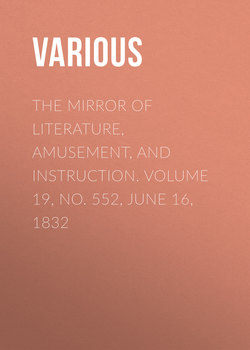The Mirror of Literature, Amusement, and Instruction. Volume 19, No. 552, June 16, 1832

Реклама. ООО «ЛитРес», ИНН: 7719571260.
Оглавление
Various. The Mirror of Literature, Amusement, and Instruction. Volume 19, No. 552, June 16, 1832
THE BRAHMIN BULL, IN THE ZOOLOGICAL GARDENS, REGENT'S PARK
ST. PANCRAS OLD CHURCH
MARY OF CAMBRIA.—A SONNET
SHAKSPERIANA
SIR THOMAS FOWLER'S LODGE, ISLINGTON
FINE ARTS
THE PANORAMA OF MILAN
SPIRIT OF THE PUBLIC JOURNALS
CHIT CHAT OF THE DAY
THE SELECTOR; AND LITERARY NOTICES OF NEW WORKS
THE MESSIAH
SPAIN AND PORTUGAL
THE GATHERER
Отрывок из книги
The Zoological Society possess several Zebus, or Indian oxen. These were formerly considered a distinct species, but zoologists are now of opinion that the Zebu is merely a variety of the common ox, "although," as Mr. Bennett observes, "it is difficult to ascertain the causes by which the distinctive characters of the two races have been in the process of time gradually produced."1 Their anatomical structure is precisely the same, and the only circumstances in which the two animals differ consist in the fatty hump on the shoulders of the Zebu, and in the somewhat more slender and delicate make of its legs.
The object of the Zoological Society in their collection of Zebus is the introduction of an improved breed of oxen. The larger specimens are kept at the farm at Kingston Hill, and only a pair of small ones are reserved for the Gardens, in addition to the Brahmin Bull, who occupies the central division of the Cattle Shed.
.....
The whole of the breeds of Zebus are treated with great veneration by the Hindoos, who hold it sinful to deprive them of life under any pretext whatever. They are in general used as beasts of draft, principally for purposes of husbandry, but a select number (of which the specimen before us is one,) are exempted from all services, and even idolized.
Bishop Heber,2 calls them Brahminy Bulls, and tells us they are turned out when calves, on different solemn occasions by wealthy Hindoos, as an acceptable offering to Siva. It would be a mortal sin to strike or injure them. They feed where they choose, and devout persons take great delight in pampering them. They are exceeding pests in the villages near Calcutta, breaking into gardens, thrusting their noses into the stalls of fruiterers and pastry-cook's shops, and helping themselves without ceremony. Like other petted animals, they are sometimes mischievous, and are said to resent with a push of their horns any delay in gratifying their wishes.
.....